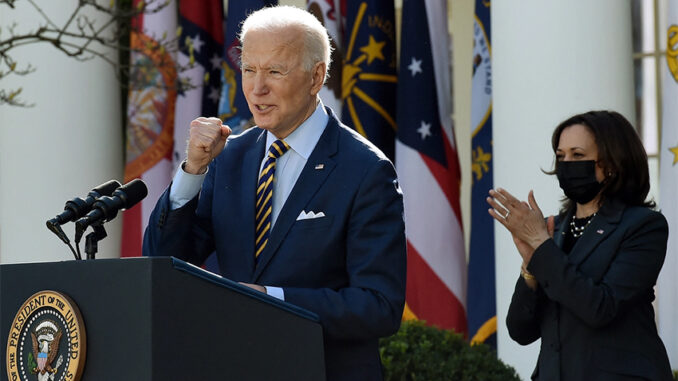
Two years after the coronavirus outbreak upended life in the United States, Americans find themselves in an environment that is at once greatly improved and frustratingly familiar.Around three-quarters of U.S. adults now report being fully vaccinated, a critical safeguard against the worst outcomes of a virus that has claimed the lives of more than 950,000 citizens. Teens and children as young as 5 are now eligible for vaccines. The national unemployment rate has plummeted from nearly 15% in the tumultuous first weeks of the outbreak to around 4% today. A large majority of K-12 parents report that their kids are back to receiving in-person instruction, and other hallmarks of public life, including sporting events and concerts, are again drawing crowds.How we did this Data essay from March 2021: A Year of U.S. Public Opinion on the Coronavirus Pandemic 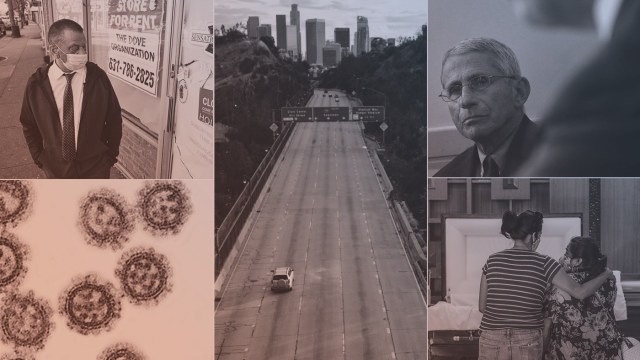 The landscape in other ways remains unsettled. The staggering death toll of the virus continues to rise, with nearly as many Americans lost in the pandemic’s second year as in the first, despite the widespread availability of vaccines. The economic recovery has been uneven, with wage gains for many workers offset by the highest inflation rate in four decades and the labor market roiled by the Great Resignation. The nation’s political fractures are reflected in near-daily disputes over mask and vaccine rules. And thorny new societal problems have emerged, including alarming increases in murder and fatal drug overdose rates that may be linked to the upheaval caused by the pandemic.For the public, the sense of optimism that the country might be turning the corner – evident in surveys shortly after President Joe Biden took office and as vaccines became widely available – has given way to weariness and frustration. A majority of Americans now give Biden negative marks for his handling of the outbreak, and ratings for other government leaders and public health officials have tumbled. Amid these criticisms, a growing share of Americans appear ready to move on to a new normal, even as the exact contours of that new normal are hard to discern.A year ago, optimism was in the airzPresident Joe Biden speaks to reporters in the White House Rose Garden in March 2021, a day after signing the $1.9 billion American Rescue Plan into law. An April survey found two-thirds of U.S. adults approved of the economic aid package. (Olivier Douliery/AFP via Getty Images)Biden won the White House in part because the public saw him as more qualified than former President Donald Trump to address the pandemic. In a January 2021 survey, a majority of registered voters said a major reason why Trump lost the election was that his administration did not do a good enough job handling the coronavirus outbreak.At least initially, Biden inspired more confidence. In February 2021, 56% of Americans said they expected the new administration’s plans and policies to improve the coronavirus situation. By last March, 65% of U.S. adults said they were very or somewhat confident in Biden to handle the public health impact of the coronavirus.
The landscape in other ways remains unsettled. The staggering death toll of the virus continues to rise, with nearly as many Americans lost in the pandemic’s second year as in the first, despite the widespread availability of vaccines. The economic recovery has been uneven, with wage gains for many workers offset by the highest inflation rate in four decades and the labor market roiled by the Great Resignation. The nation’s political fractures are reflected in near-daily disputes over mask and vaccine rules. And thorny new societal problems have emerged, including alarming increases in murder and fatal drug overdose rates that may be linked to the upheaval caused by the pandemic.For the public, the sense of optimism that the country might be turning the corner – evident in surveys shortly after President Joe Biden took office and as vaccines became widely available – has given way to weariness and frustration. A majority of Americans now give Biden negative marks for his handling of the outbreak, and ratings for other government leaders and public health officials have tumbled. Amid these criticisms, a growing share of Americans appear ready to move on to a new normal, even as the exact contours of that new normal are hard to discern.A year ago, optimism was in the airzPresident Joe Biden speaks to reporters in the White House Rose Garden in March 2021, a day after signing the $1.9 billion American Rescue Plan into law. An April survey found two-thirds of U.S. adults approved of the economic aid package. (Olivier Douliery/AFP via Getty Images)Biden won the White House in part because the public saw him as more qualified than former President Donald Trump to address the pandemic. In a January 2021 survey, a majority of registered voters said a major reason why Trump lost the election was that his administration did not do a good enough job handling the coronavirus outbreak.At least initially, Biden inspired more confidence. In February 2021, 56% of Americans said they expected the new administration’s plans and policies to improve the coronavirus situation. By last March, 65% of U.S. adults said they were very or somewhat confident in Biden to handle the public health impact of the coronavirus.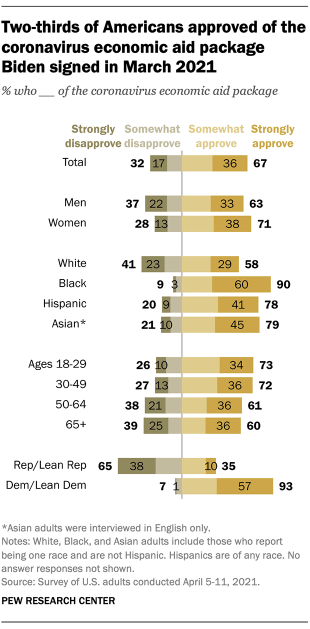 The rapid deployment of vaccines only burnished Biden’s standing. After the new president easily met his goal of distributing 100 million doses in his first 100 days in office, 72% of Americans – including 55% of Republicans – said the administration was doing an excellent or good job overseeing the production and distribution of vaccines. As of this January, majorities in every major demographic group said they had received at least one dose of a vaccine. Most reported being fully vaccinated – defined at the time as having either two Pfizer or Moderna vaccines or one Johnson & Johnson – and most fully vaccinated adults said they had received a booster shot, too.The Biden administration’s early moves on the economy also drew notable public support. Two-thirds of Americans, including around a third of Republicans, approved of the $1.9 trillion aid package Biden signed into law last March, one of several sprawling economic interventions authorized by administrations of both parties in the outbreak’s first year. Amid the wave of government spending, the U.S. economy grew in 2021 at its fastest annual rate since 1984.Globally, people preferred Biden’s approach to the pandemic over Trump’s. Across 12 countries surveyed in both 2020 and 2021, the median share of adults who said the U.S. was doing a good job responding to the outbreak more than doubled after Biden took office. Even so, people in these countries gave the U.S. lower marks than they gave to Germany, the World Health Organization and other countries and multilateral organizations. Data essay: The Changing Political Geography of COVID-19 Over the Last Two Years
The rapid deployment of vaccines only burnished Biden’s standing. After the new president easily met his goal of distributing 100 million doses in his first 100 days in office, 72% of Americans – including 55% of Republicans – said the administration was doing an excellent or good job overseeing the production and distribution of vaccines. As of this January, majorities in every major demographic group said they had received at least one dose of a vaccine. Most reported being fully vaccinated – defined at the time as having either two Pfizer or Moderna vaccines or one Johnson & Johnson – and most fully vaccinated adults said they had received a booster shot, too.The Biden administration’s early moves on the economy also drew notable public support. Two-thirds of Americans, including around a third of Republicans, approved of the $1.9 trillion aid package Biden signed into law last March, one of several sprawling economic interventions authorized by administrations of both parties in the outbreak’s first year. Amid the wave of government spending, the U.S. economy grew in 2021 at its fastest annual rate since 1984.Globally, people preferred Biden’s approach to the pandemic over Trump’s. Across 12 countries surveyed in both 2020 and 2021, the median share of adults who said the U.S. was doing a good job responding to the outbreak more than doubled after Biden took office. Even so, people in these countries gave the U.S. lower marks than they gave to Germany, the World Health Organization and other countries and multilateral organizations. Data essay: The Changing Political Geography of COVID-19 Over the Last Two Years  A familiar undercurrent of partisan division Even if the national mood seemed to be improving last spring, the partisan divides that became so apparent in the first year of the pandemic did not subside. If anything, they intensified and moved into new arenas.
A familiar undercurrent of partisan division Even if the national mood seemed to be improving last spring, the partisan divides that became so apparent in the first year of the pandemic did not subside. If anything, they intensified and moved into new arenas.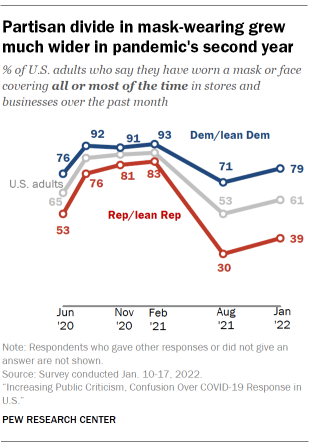 Masks and vaccines remained two of the most high-profile areas of contention. In February 2021, Republicans were only 10 percentage points less likely than Democrats (83% vs. 93%) to say they had worn a face covering in stores or other businesses all or most of the time in the past month. By January of this year, Republicans were 40 points less likely than Democrats to say they had done so (39% vs. 79%), even though new coronavirus cases were at an all-time high.Republicans were also far less likely than Democrats to be fully vaccinated (60% vs. 85%) and to have received a booster shot (33% vs. 62%) as of January. Not surprisingly, they were much less likely than Democrats to favor vaccination requirements for a variety of activities, including traveling by airplane, attending a sporting event or concert, and eating inside of a restaurant.Some of the most visible disputes involved policies at K-12 schools, including the factors that administrators should consider when deciding whether to keep classrooms open for in-person instruction. In January, Republican K-12 parents were more likely than Democrats to say a lot of consideration should be given to the possibility that kids will fall behind academically without in-person classes and the possibility that students will have negative emotional consequences if they don’t attend school in person. Democratic parents were far more likely than Republicans to say a lot of consideration should be given to the risks that COVID-19 poses to students and teachers.
Masks and vaccines remained two of the most high-profile areas of contention. In February 2021, Republicans were only 10 percentage points less likely than Democrats (83% vs. 93%) to say they had worn a face covering in stores or other businesses all or most of the time in the past month. By January of this year, Republicans were 40 points less likely than Democrats to say they had done so (39% vs. 79%), even though new coronavirus cases were at an all-time high.Republicans were also far less likely than Democrats to be fully vaccinated (60% vs. 85%) and to have received a booster shot (33% vs. 62%) as of January. Not surprisingly, they were much less likely than Democrats to favor vaccination requirements for a variety of activities, including traveling by airplane, attending a sporting event or concert, and eating inside of a restaurant.Some of the most visible disputes involved policies at K-12 schools, including the factors that administrators should consider when deciding whether to keep classrooms open for in-person instruction. In January, Republican K-12 parents were more likely than Democrats to say a lot of consideration should be given to the possibility that kids will fall behind academically without in-person classes and the possibility that students will have negative emotional consequences if they don’t attend school in person. Democratic parents were far more likely than Republicans to say a lot of consideration should be given to the risks that COVID-19 poses to students and teachers.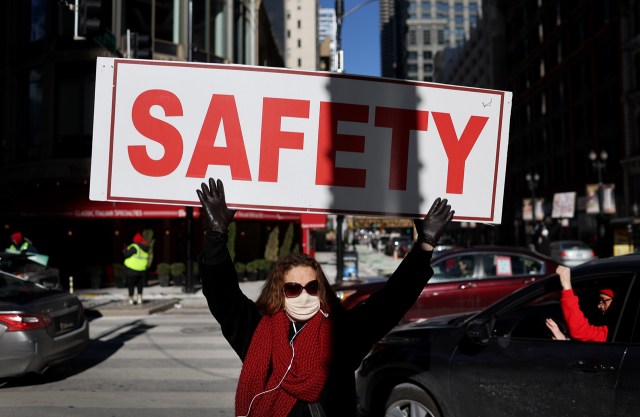 A woman shows her support for a Chicago Teachers Union car caravan around City Hall on Jan. 10, 2022. As COVID-19 cases surged, union members were protesting the continuation of in-person learning in city schools without more safeguards in place. (Scott Olson/Getty Images)The common thread running through these disagreements is that Republicans remain fundamentally less concerned about the virus than Democrats, despite some notable differences in attitudes and behaviors within each party. In January, almost two-thirds of Republicans (64%) said the coronavirus outbreak has been made a bigger deal than it really is. Most Democrats said the outbreak has either been approached about right (50%) or made a smaller deal than it really is (33%). (All references to Republicans and Democrats include independents who lean toward each party.)New variants and new problemsThe decline in new coronavirus cases, hospitalizations and deaths that took place last spring and summer was so encouraging that Biden announced in a July 4 speech that the nation was “closer than ever to declaring our independence from a deadly virus.” But the arrival of two new variants – first delta and then omicron – proved Biden’s assessment premature.Some 350,000 Americans have died from COVID-19 since July 4, including an average of more than 2,500 a day at some points during the recent omicron wave – a number not seen since the first pandemic winter, when vaccines were not widely available. The huge number of deaths has ensured that even more Americans have a personal connection to the tragedy.
A woman shows her support for a Chicago Teachers Union car caravan around City Hall on Jan. 10, 2022. As COVID-19 cases surged, union members were protesting the continuation of in-person learning in city schools without more safeguards in place. (Scott Olson/Getty Images)The common thread running through these disagreements is that Republicans remain fundamentally less concerned about the virus than Democrats, despite some notable differences in attitudes and behaviors within each party. In January, almost two-thirds of Republicans (64%) said the coronavirus outbreak has been made a bigger deal than it really is. Most Democrats said the outbreak has either been approached about right (50%) or made a smaller deal than it really is (33%). (All references to Republicans and Democrats include independents who lean toward each party.)New variants and new problemsThe decline in new coronavirus cases, hospitalizations and deaths that took place last spring and summer was so encouraging that Biden announced in a July 4 speech that the nation was “closer than ever to declaring our independence from a deadly virus.” But the arrival of two new variants – first delta and then omicron – proved Biden’s assessment premature.Some 350,000 Americans have died from COVID-19 since July 4, including an average of more than 2,500 a day at some points during the recent omicron wave – a number not seen since the first pandemic winter, when vaccines were not widely available. The huge number of deaths has ensured that even more Americans have a personal connection to the tragedy.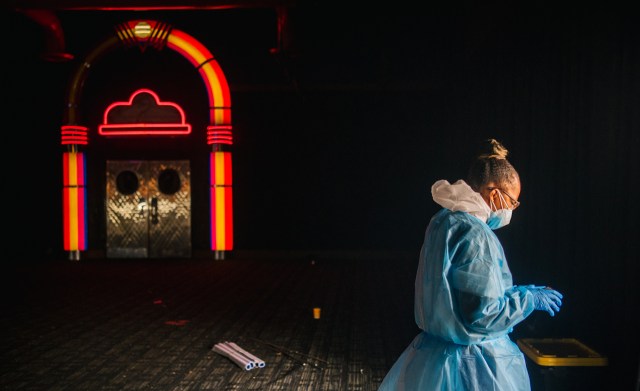 A medical assistant walks out of a Dave & Buster’s-turned-COVID-19 testing facility in Houston on Jan. 8, 2022. (Brandon Bell/Getty Images)The threat of dangerous new variants had always loomed, of course. In February 2021, around half of Americans (51%) said they expected that new variants would lead to a major setback in efforts to contain the disease. But the ferocity of the delta and omicron surges still seemed to take the public aback, particularly when governments began to reimpose restrictions on daily life.After announcing in May 2021 that vaccinated people no longer needed to wear masks in public, the Centers for Disease Control and Prevention reversed course during the delta wave and again recommended indoor mask-wearing for those in high-transmission areas. Local governments brought back their own mask mandates. Later, during the omicron wave, some major cities imposed new proof-of-vaccination requirements, while the CDC shortened its recommended isolation period for those who tested positive for the virus but had no symptoms. This latter move was at least partly aimed at addressing widespread worker shortages, including at airlines struggling during the height of the holiday travel season.
A medical assistant walks out of a Dave & Buster’s-turned-COVID-19 testing facility in Houston on Jan. 8, 2022. (Brandon Bell/Getty Images)The threat of dangerous new variants had always loomed, of course. In February 2021, around half of Americans (51%) said they expected that new variants would lead to a major setback in efforts to contain the disease. But the ferocity of the delta and omicron surges still seemed to take the public aback, particularly when governments began to reimpose restrictions on daily life.After announcing in May 2021 that vaccinated people no longer needed to wear masks in public, the Centers for Disease Control and Prevention reversed course during the delta wave and again recommended indoor mask-wearing for those in high-transmission areas. Local governments brought back their own mask mandates. Later, during the omicron wave, some major cities imposed new proof-of-vaccination requirements, while the CDC shortened its recommended isolation period for those who tested positive for the virus but had no symptoms. This latter move was at least partly aimed at addressing widespread worker shortages, including at airlines struggling during the height of the holiday travel season.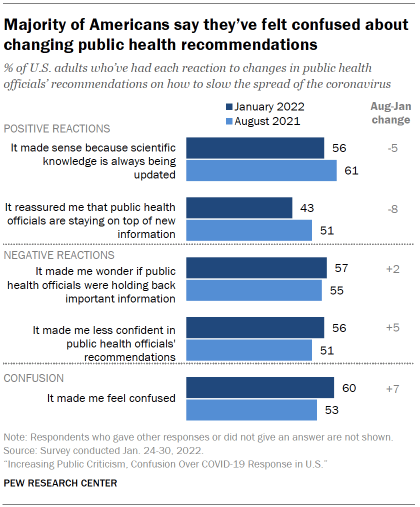 Amid these changes, public frustration was mounting. Six-in-ten adults said in January 2022 that the changing guidance about how to slow the spread of the virus had made them feel confused, up from 53% the previous August. More than half said the shifting guidance had made them wonder if public health officials were withholding important information (57%) and made them less confident in these officials’ recommendations (56%). And only half of Americans said public health officials like those at the CDC were doing an excellent or good job responding to the outbreak, down from 60% last August and 79% in the early stages of the pandemic.Economic concerns, particularly over rising consumer prices, were also clearly on the rise. Around nine-in-ten adults (89%) said in January that prices for food and consumer goods were worse than a year earlier. Around eight-in-ten said the same thing about gasoline prices (82%) and the cost of housing (79%). These assessments were shared across party lines and backed up by government data showing large cost increases for many consumer goods and services.Overall, only 28% of adults described national economic conditions as excellent or good in January, and a similarly small share (27%) said they expected economic conditions to be better in a year. Strengthening the economy outranked all other issues when Americans were asked what they wanted Biden and Congress to focus on in the year ahead.Looking at the bigger picture, nearly eight-in-ten Americans (78%) said in January that they were not satisfied with the way things were going in the country.Imagining the new normalAs the third year of the U.S. coronavirus outbreak approaches, Americans increasingly appear willing to accept pandemic life as the new reality.Large majorities of adults now say they are comfortable doing a variety of everyday activities, including visiting friends and family inside their home (85%), going to the grocery store (84%), going to a hair salon or barbershop (73%) and eating out in a restaurant (70%). Among those who have been working from home, a growing share say they would be comfortable returning to their office if it were to reopen soon.
Amid these changes, public frustration was mounting. Six-in-ten adults said in January 2022 that the changing guidance about how to slow the spread of the virus had made them feel confused, up from 53% the previous August. More than half said the shifting guidance had made them wonder if public health officials were withholding important information (57%) and made them less confident in these officials’ recommendations (56%). And only half of Americans said public health officials like those at the CDC were doing an excellent or good job responding to the outbreak, down from 60% last August and 79% in the early stages of the pandemic.Economic concerns, particularly over rising consumer prices, were also clearly on the rise. Around nine-in-ten adults (89%) said in January that prices for food and consumer goods were worse than a year earlier. Around eight-in-ten said the same thing about gasoline prices (82%) and the cost of housing (79%). These assessments were shared across party lines and backed up by government data showing large cost increases for many consumer goods and services.Overall, only 28% of adults described national economic conditions as excellent or good in January, and a similarly small share (27%) said they expected economic conditions to be better in a year. Strengthening the economy outranked all other issues when Americans were asked what they wanted Biden and Congress to focus on in the year ahead.Looking at the bigger picture, nearly eight-in-ten Americans (78%) said in January that they were not satisfied with the way things were going in the country.Imagining the new normalAs the third year of the U.S. coronavirus outbreak approaches, Americans increasingly appear willing to accept pandemic life as the new reality.Large majorities of adults now say they are comfortable doing a variety of everyday activities, including visiting friends and family inside their home (85%), going to the grocery store (84%), going to a hair salon or barbershop (73%) and eating out in a restaurant (70%). Among those who have been working from home, a growing share say they would be comfortable returning to their office if it were to reopen soon.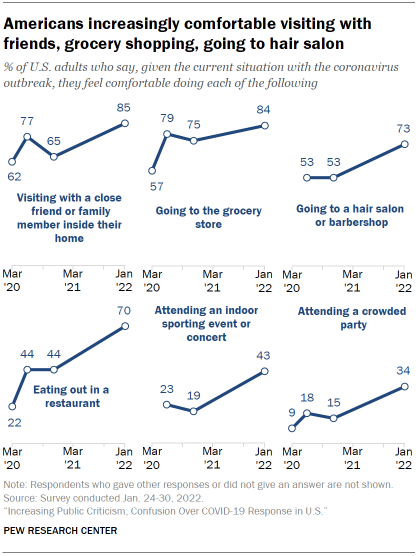 With the delta and omicron variants fresh in mind, the public also seems to accept the possibility that regular booster shots may be necessary. In January, nearly two-thirds of adults who had received at least one vaccine dose (64%) said they would be willing to get a booster shot about every six months. The CDC has since published research showing that the effectiveness of boosters began to wane after four months during the omicron wave.Despite these and other steps toward normalcy, uncertainty abounds in many other aspects of public life.The pandemic has changed the way millions of Americans do their jobs, raising questions about the future of work. In January, 59% of employed Americans whose job duties could be performed remotely reported that they were still working from home all or most of the time. But unlike earlier in the pandemic, the majority of these workers said they were doing so by choice, not because their workplace was closed or unavailable.A long-term shift toward remote work could have far-reaching societal implications, some good, some bad. Most of those who transitioned to remote work during the pandemic said in January that the change had made it easier for them to balance their work and personal lives, but most also said it had made them feel less connected to their co-workers.The shift away from office spaces also could spell trouble for U.S. downtowns and the economies they sustain. An October 2021 survey found a decline in the share of Americans who said they preferred to live in a city and an increase in the share who preferred to live in a suburb. Earlier in 2021, a growing share of Americans said they preferred to live in a community where the houses are larger and farther apart, even if stores, schools and restaurants are farther away.
With the delta and omicron variants fresh in mind, the public also seems to accept the possibility that regular booster shots may be necessary. In January, nearly two-thirds of adults who had received at least one vaccine dose (64%) said they would be willing to get a booster shot about every six months. The CDC has since published research showing that the effectiveness of boosters began to wane after four months during the omicron wave.Despite these and other steps toward normalcy, uncertainty abounds in many other aspects of public life.The pandemic has changed the way millions of Americans do their jobs, raising questions about the future of work. In January, 59% of employed Americans whose job duties could be performed remotely reported that they were still working from home all or most of the time. But unlike earlier in the pandemic, the majority of these workers said they were doing so by choice, not because their workplace was closed or unavailable.A long-term shift toward remote work could have far-reaching societal implications, some good, some bad. Most of those who transitioned to remote work during the pandemic said in January that the change had made it easier for them to balance their work and personal lives, but most also said it had made them feel less connected to their co-workers.The shift away from office spaces also could spell trouble for U.S. downtowns and the economies they sustain. An October 2021 survey found a decline in the share of Americans who said they preferred to live in a city and an increase in the share who preferred to live in a suburb. Earlier in 2021, a growing share of Americans said they preferred to live in a community where the houses are larger and farther apart, even if stores, schools and restaurants are farther away.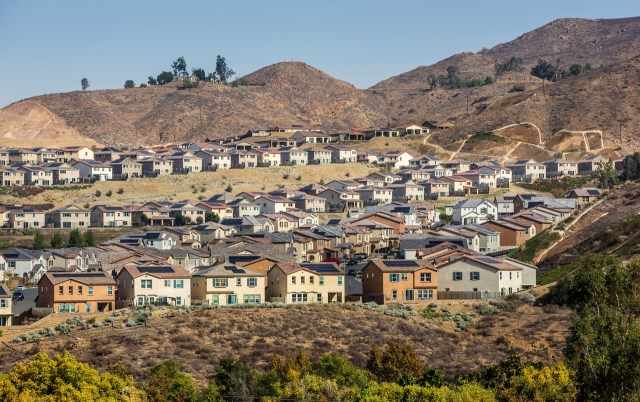 A tract of hillside homes in Temescal Valley, California, in November 2021. An October survey found that compared with before the pandemic, Americans were more likely to want to live in suburbs and less likely to want to live in urban areas. (George Rose/Getty Images)When it comes to keeping K-12 schools open, parental concerns about students’ academic progress and their emotional well-being now clearly outweigh concerns about kids and teachers being exposed to COVID-19. But disputes over school mask and vaccine rules have expanded into broader debates about public education, including the role parents should play in their children’s instruction. The Great Resignation has not spared K-12 schools, leaving many districts with shortages of teachers, bus drivers and other employees.The turmoil in the labor market also could exacerbate long-standing inequities in American society. Among people with lower levels of education, women have left the labor force in greater numbers than men. Personal experiences at work and at home have also varied widely by race, ethnicity and household income level.Looming over all of this uncertainty is the possibility that new variants of the coronavirus will emerge and undermine any collective sense of progress. Should that occur, will offices, schools and day care providers again close their doors, complicating life for working parents? Will mask and vaccine mandates snap back into force? Will travel restrictions return? Will the economic recovery be interrupted? Will the pandemic remain a leading fault line in U.S. politics, particularly as the nation approaches a key midterm election?The public, for its part, appears to recognize that a swift return to life as it was before the pandemic is unlikely. Even before the omicron variant tore through the country, a majority of Americans expected that it would be at least a year before their own lives would return to their pre-pandemic normal. That included one-in-five who predicted that their own lives would never get back to the way they were before COVID-19.
A tract of hillside homes in Temescal Valley, California, in November 2021. An October survey found that compared with before the pandemic, Americans were more likely to want to live in suburbs and less likely to want to live in urban areas. (George Rose/Getty Images)When it comes to keeping K-12 schools open, parental concerns about students’ academic progress and their emotional well-being now clearly outweigh concerns about kids and teachers being exposed to COVID-19. But disputes over school mask and vaccine rules have expanded into broader debates about public education, including the role parents should play in their children’s instruction. The Great Resignation has not spared K-12 schools, leaving many districts with shortages of teachers, bus drivers and other employees.The turmoil in the labor market also could exacerbate long-standing inequities in American society. Among people with lower levels of education, women have left the labor force in greater numbers than men. Personal experiences at work and at home have also varied widely by race, ethnicity and household income level.Looming over all of this uncertainty is the possibility that new variants of the coronavirus will emerge and undermine any collective sense of progress. Should that occur, will offices, schools and day care providers again close their doors, complicating life for working parents? Will mask and vaccine mandates snap back into force? Will travel restrictions return? Will the economic recovery be interrupted? Will the pandemic remain a leading fault line in U.S. politics, particularly as the nation approaches a key midterm election?The public, for its part, appears to recognize that a swift return to life as it was before the pandemic is unlikely. Even before the omicron variant tore through the country, a majority of Americans expected that it would be at least a year before their own lives would return to their pre-pandemic normal. That included one-in-five who predicted that their own lives would never get back to the way they were before COVID-19.



Be the first to comment